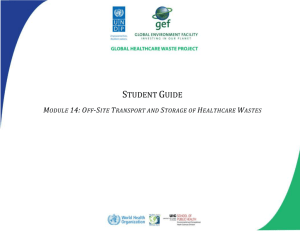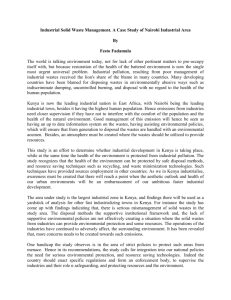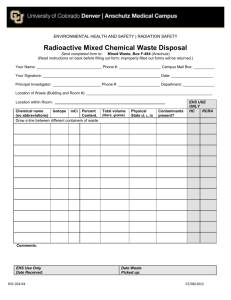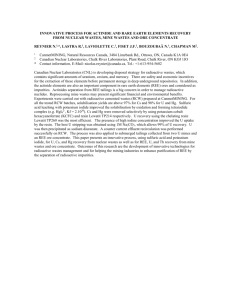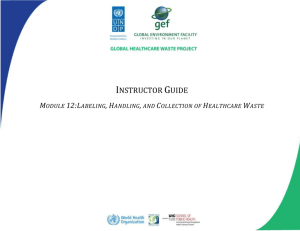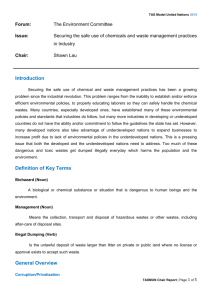Instructor Guide - UNDP GEF Global Healthcare Waste Project
advertisement
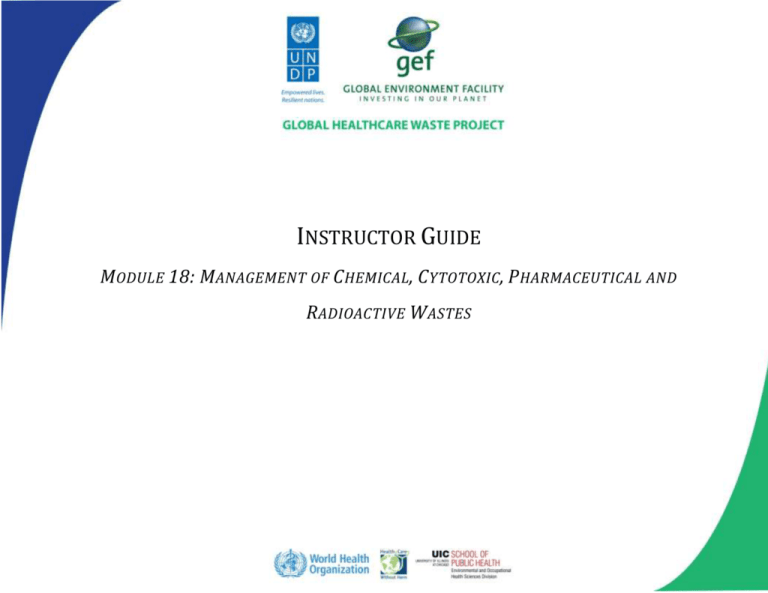
UNDP GEF Project on Global Healthcare Waste INSTRUCTOR GUIDE MODULE 18: MANAGEMENT OF CHEMICAL , CYTOTOXIC , P HARMACEUTICAL AND RADIOACTIVE WASTES 1 UNDP GEF Project on Global Healthcare Waste MODULE 18: MANAGEMENT OF CHEMICAL, CYTOTOXIC, PHARMACEUTICAL AND RADIOACTIVE WASTES Estimated Time Module Overview Learning Objectives Target Audience Lecture: 1 hour Activity: 1 hour *This activity may also be distributed after Module 20 about mercury, specifically, depending upon audiences Describe sources and types of chemical, cytotoxic, pharmaceutical, and radioactive wastes in a healthcare setting Discuss risks associated with exposure to these specific wastes Describe all aspects of management of these specific wastes Describe treatment and disposal methods Identify hazardous (non-infectious) wastes in a healthcare facility Identify key steps in collection, handling, storage, transport, treatment and disposal of these wastes Note: If the facility already has an inventory of chemicals used and stored in the facility, the inventory could be a guide to determine which departments and staff should take this module. HCWM Coordinators Facility Managers Other management staff Healthcare professionals and staff working in chemotherapy, pharmacy, radiology, radiation therapy and in the laboratories Facility engineering, central sterile supply and housekeeping staff dealing with maintenance waste, disinfectants, and chemicals (Note: Presentation slides should be adjusted to fit the needs of cleaner and other auxiliary staff.) 2 UNDP GEF Project on Global Healthcare Waste Instructor Preparation Materials Needed Tailor the module to the specific audience. For example, training of the pharmacy staff should focus on the slides relevant to pharmaceutical waste. Make notes pages of PowerPoint slides to hand out to class Make copies of class exercise for distribution after PowerPoint presentation Read/review Chapters 2, 7, 8 in Blue Book, and other materials included in the References Gather country and region specific data to include in presentation Make copies of any additional documents/readings that may be handed out to class, such as those included in the References Select one or two chemicals to assign to each group. Review the ICSCs and MDSDs available on the selected chemicals. As much as possible, assign chemicals based on chemicals that participants have identified as ones that they used in the work. If the participants’ facilities are not mercury free, assign mercury as one of the chemicals. Examples of common chemicals are: glutaraldehyde and isopropanol (for nursing staff), sodium hypochlorite and phenol (for nursing and cleaning staff), xylene or toluene or methanol (for laboratory staff), ethylene oxide (for central sterile supply staff), fluoracil or cisplatin or uracil (for chemotherapy staff), nitrous oxide or enflurante or isoflurane (for surgical staff), hydroquinone or acetic acid (for radiology staff), trichloroethylene or methylene chloride (for engineering and maintenance staff), etc. Prepare any additional notes to be discussed during the presentation Prepare any additional discussion points or review questions Projector Student handouts: slides, exercise, homework Flip chart and marker pens and/or board and chalk 3 UNDP GEF Project on Global Healthcare Waste Student Preparation Review Questions Blue Book Chapter 2, 7, 8 Think about how your facility manages chemical, cytotoxic, pharmaceutical, and radioactive wastes Conduct a survey of your particular department and prepare an inventory of the chemicals in use, including information on chemical name, CAS #, quantity, expiration date, storage location, and user. Also make note if the department has an MSDS or International Chemical Safety Cards or other information on the chemical. Select two chemicals, preferably the most commonly used chemicals, and research the physical properties, health effects, symptoms of exposure, recommended storage requirements, and environmental impacts of the selected chemical. Most of this information can be found in the MSDS or ICSC. What are some sources of chemical, cytotoxic, and pharmaceutical wastes in your facility? What are some examples of these healthcare wastes that may occur both inside and outside of your facility? What are some major hazards and risks that are posed by these wastes? What are some sources of radioactive wastes in your facility? Give some examples, as well as their hazards and risks. How does your facility segregate chemical and pharmaceutical wastes? What about specific wastes that have cytotoxic and/or genotoxic properties? What handling and safety procedures are followed by those who deal directly with the wastes? How does your facility store chemical, cytotoxic, pharmaceutical, and radioactive wastes? What treatment and disposal methods does it use or has it used in the past for each category of waste? What are country/region-specific policies and guidelines for chemical and radioactive waste management? What about international guidelines specifically meant for radioactive wastes? Is your facility able to follow these guidelines? How does your facility regulate mercury? Are there plans to use alternative sources in place of mercury and to eventually phase out its use in most medical equipment? Does your country receive assistance from the Global Healthcare Waste Project? 4 UNDP GEF Project on Global Healthcare Waste PRESENTATION Slide Number/Title Teacher’s Notes Slide 1: Title Slide Slide 2: Module Overview Introduce the outline and major points of the presentation Slide 3: Learning Objectives Describe what participants will learn at the end of this module. Slide 4: Sources & Examples of Hazardous (Non-Infectious) Wastes Slide 5: Characteristics of Chemical Waste Ask class for some examples as you go through the list on this slide Slide 6: General Types of Chemical Wastes Slide 7: Examples of Chemical Waste Containing Heavy Metals Slide 8: Health Impacts of Chemical Exposure Discarded solid, liquid and gaseous chemicals that are: -toxic -corrosive -flammable -reactive -oxidizing Go through the list of chemical wastes that contain certain heavy metals (mercury, cadmium, lead) Describe some of the major health effects of chemical exposure in the next few slides. Examples of chemicals that produce the health effects listed are given in the parentheses. -Effects on the lungs -Effects on the eyes and mucous membranes Slide 9: Health Impacts of Chemical Exposure -Effects on the skin -Effects on the nervous system 5 UNDP GEF Project on Global Healthcare Waste Slide 10: Health Impacts of Chemical Exposure Examples of chemicals that produce the health effects listed are given under each health effect. -Effects on the liver and kidneys -Effects on the reproductive system -Cancers Slide 11: Segregation of Chemical Waste Slide 12: Containers and Color Coding for Chemical Waste Chemical wastes should be segregated based upon compatibility. Slide 13: Labeling of Chemical Waste Go over the elements that should be included in the labeling of chemical waste containers. It is important to use proper/consistent color coding procedures for chemical wastes. Replace slide with the country’s color coding if different. This slide should be replaced with the country’s specific labeling requirements, if available. Slide 14: International Chemical Waste Symbols Slide 15: Handling of Chemical Waste Ensure that proper PPE is worn when handling any hazardous chemicals, with specific equipment required depending on the characteristics of the chemical. Slide 16: Handling of Chemical Waste When handling the waste make sure that: -appropriate transferring methods are used -spill kit is available and easily accessible -secondary containment measures should are in place Slide 17: On-Site Transport of Chemical Waste Describe strict on-site transport specifications for chemical wastes 6 UNDP GEF Project on Global Healthcare Waste Slide 18: Storage of Chemical Waste Should be in an enclosed area separate from other waste storage areas, with sufficient lighting and good ventilation. When liquid chemicals are being stored, the area should be equipped with a liquid and chemical-proof sump. If this is not present, catchcontainers should be placed under the storage containers to catch leaked liquids. Spillage kits, proper PPE, and first aid equipment should be nearby in the central storage area. Slide 19: Storage of Chemical Waste -No mixing of wastes -Incompatible wastes stored separately; liquid and solid wastes should be stored separately -Temperature-controlled Slide 20: Sample Sketch of a Chemical Based on Figure 7.12 of the WHO Blue Book Waste Storage Area Slide 21: Storage of Chemical Waste Slide 22: Off-Site Transport This slide should be replaced with national requirements if available. Slide 23: Treatment of Chemical Waste Treatment categories include: -chemical and physical treatment -biological treatment -thermal treatment Slide 24: Treatment of Chemical Waste in Low-Income Countries Incineration is not an ideal method for treating radioactive wastes. Encapsulation or inertization are better options if available. Encapsulation: Waste-filled containers are tightly sealed after an immobilizing material is added. Inertization: Process of mixing waste with cement and other substances before disposal so as to minimize the risk of toxic substances migrating into surface water or groundwater. 7 UNDP GEF Project on Global Healthcare Waste Slide 25: Chemical Wastes Containing Heavy Metals Slide 26: Chemical Waste Management Slide 27: Workers’ Right to Know Discuss the proper handling, storage, and disposal of chemical wastes containing heavy metals Describe major aspects of chemical waste management More about Principle 10 of the Rio Declaration can be found in: http://www.unitar.org/egp/sites/unitar.org.egp/files/p10_EN_rio.declaration.pdf Slide 28: Safety Data Sheets List of the sections of an SDS Slide 29: Example of an ICSC The example only shows the first few sections of an ICSC for glutaraldehyde (50% solution). ICSCs can be found at the International Labour Organisation website at: http://www.ilo.org/dyn/icsc/showcard.home Slide 30: Example of a Safety Data Sheet This example only shows the first page of a six-page MSDS for xylene. MSDSs or SDSs can be found on the Internet or obtained from manufacturers. Slide 31: Chemical Waste Minimization Slide 32: Chemical Waste Minimization Slide 33: Chemotherapeutic Waste Source reduction is the most desirable method for minimizing waste Slide 34: Examples of Cytotoxic Waste Slide 35: Segregation of Cytotoxic Waste Give some sources and examples of specific agents of cytotoxic waste Describe recycling as a waste minimization technique Introduce different types of chemotherapeutic wastes Describe chemical degradation, high-temperature incineration with air pollution control, options for low-income countries Slide 36: Treatment and Disposal of Chemotherapeutic Waste Slide 37: Chemotherapeutic Waste Minimization 8 UNDP GEF Project on Global Healthcare Waste Slide 38: Characteristics of Radioactive Wastes Go over some of the characteristics of radioactive wastes. Radionuclides used in healthcare activities are generally in unsealed (open) sources or sealed sources. Unsealed sources are generally liquids applied directly, while sealed sources are radioactive substances contained in parts of equipment or encapsulated in unbreakable or impervious objects. Slide 39: Sources of Radioactive Wastes in Healthcare Slide 40: Health Risks of Radioactive Waste Slide 41: Containers for Radioactive Wastes Slide 42: Segregation of Radioactive Waste There are many potential sources of radioactive waste in healthcare activities The health impacts of radioactive wastes will be determined by the type and extent of exposure to ionizing radiation. Segregation of radioactive wastes should be based on: -half-life -activity and radionuclide content -physical and chemical form -sealed/non-sealed sources -waste content Radioactive waste should also be segregated on the basis of the available options for treatment, conditioning, storage, and disposal. Slide 43: Labeling of Radioactive Waste Slide 44: Storage of Radioactive Waste It is essential that radioactive wastes are properly labeled. Slide 45: Disposal of Radioactive Waste Options for the disposal of radioactive waste include: return to supplier, “decay in storage”, and long-term storage (at an authorized radioactive waste disposal facility). Many precautions should be taken and steps followed to ensure safety in the storage of radioactive wastes. 9 UNDP GEF Project on Global Healthcare Waste Slide 46: Radioactive Waste Minimization Slide 47: Sources of Pharmaceutical Waste Slide 48: Characteristics of Pharmaceutical Waste Slide 49: Environmental Impact of Pharmaceutical Waste Slide 50: Segregation of Pharmaceutical Waste Pharmaceuticals can be: -acutely hazardous -toxic -flammable or ignitable -corrosive Pharmaceutical wastes should be segregated from other infectious and radioactive wastes. National and local regulations must be followed. Slide 51: Treatment and Disposal of Pharmaceutical Waste 10 UNDP GEF Project on Global Healthcare Waste Slide 52: Disposal of Pharmaceutical Waste in Low-Income Countries Options for the disposal of pharmaceutical wastes in low-income countries include: -reverse distribution (returning to supplier) -safe burial on hospital premises -encapsulation of inertization -landfill disposal -discharge to a sewer Sources: Waste disposal http://www.healthcarewaste.org/fileadmin/user_upload/resources/WDU_guidelines 2_en.pdf Waste reduction http://www.healthcarewaste.org/fileadmin/user_upload/resources/10_Steps_to_Impl ementing_a_Regulated_Medical_Waste_Reduction_Plan.pdf http://archive.basel.int/pub/techguid/tech-biomedical.pdf http://www.healthcarewaste.org/fileadmin/user_upload/resources/who_first_do_no_ harm_2002.pdf Slide 53: Pharmaceutical Waste Minimization Keys strategies for minimizing pharmaceutical wastes are: good inventory control, avoidance of unnecessary prescriptions, and the reformulation of drugs Slide 54-55: Discussion Generate a discussion of the review questions. 11 UNDP GEF Project on Global Healthcare Waste References (in order as they appear in slides) Blue Book, Chapter 2, 7, 8 UNDP, GEF: Global Healthcare Waste Project. www.gefmedwaste.org World Health Organization. Managing Health Care Waste Disposal: Guidelines on to Construct, Use, and Maintain a Waste Disposal Unit. September, 2004 http://www.healthcarewaste.org/fileadmin/user_upload/resources/WDU_guidelines 2_en.pdf Hospitals for a Healthy Environment. Regulated Medical Waste Reduction: 10 Steps to Implementing a Regulated Medical Waste Reduction Plan. http://www.healthcarewaste.org/fileadmin/user_upload/resources/10_Steps_to_Impl ementing_a _Regulated_Medical_Waste_Reduction_Plan.pdf UNEP, Basel Convention. Technical Guidelines on the Environmentally Sound Management of Biomedical and Healthcare Wastes. September, 2003 http://archive.basel.int/pub/techguid/tech-biomedical.pdf WHO, Department of Protection of the Human Environment, Department of Vaccines and Biologicals. First Do No Harm: Introducing Auto-Disable Syringes and Ensuring Injection Safety in Immunization Systems of Developing Countries. http://www.healthcarewaste.org/fileadmin/user_upload/resources/who_first_do_no_ harm_2002.pdf WHO, Department of the Protection of the Environment, Water, Sanitation, and Health. Mercury in Health Care: Policy Paper. http://www.healthcarewaste.org/fileadmin/user_upload/resources/WHO-mercuryin-HC-policy-paper-2005.pdf WHO, UNDP, Global Healthcare Waste Project: Mercury. http://gefmedwaste.org/section.php?id=31 12 UNDP GEF Project on Global Healthcare Waste ACTIVITY: MODULE 18: EXERCISE (1 HOUR) Knowledge and understanding of toxicity, risk of exposure, and health impact of a chemical is very important for the safe use and disposal of chemicals in a healthcare facility. The purpose of this exercise is to learn how to find qualitative information on chemical exposure from the label, materials safety data sheets (MSDSs) and the ILO International Occupational Safety and Health Information Centre (CIS). Use other accompanying documents about phasing out mercury in health care and the health effects of mercury. MSDSs are prepared by a chemical manufacturer and provide basic information on the chemical, physical properties, and related health effects. The MSDSs gives guidance on using, storing and handling substances safely on the job and in emergencies such as fires and spills. However, information on MSDSs may be incomplete or inaccurate. MSDSs are another piece of information that can help to better understand workplace exposures. The CIS forms contain information on types of hazard/exposure, acute symptoms, prevention and first aid/fire fighting. Instructor: Break class into groups of three or more, and distribute exercise at beginning of class. You may group participants by facility, department, or job type. Participants will complete the activity in groups and record their answers. Instructor should record participant/group responses on a wipe board, flip chart, or transparency, categorize their responses. Instructor may provide the resources and other reading material as homework, so students have the time to be familiar with the materials before the activity. Instructor may also choose to use the common websites listed to identify any other chemical used at the facility. Instructor will go over the responses, once again, during the de-brief. Resources for Mercury: http://www.cdc.gov/niosh/ipcsneng/neng0056.html http://www.sciencelab.com/msds.php?msdsId=9927224 http://www.cdc.gov/niosh/npg/npgd0383.html http://www.cdc.gov/niosh/npg/npgd0384.html http://gefmedwaste.org/downloads/WHO%20Policy%20Paper:%20Mercury%20in%20Health%20Care.pdf http://gefmedwaste.org/section.php?id=31 13 UNDP GEF Project on Global Healthcare Waste http://gefmedwaste.org/downloads/NOTES%20on%20Selecting%20Mercury%20Reduction%20Activities.pdf http://gefmedwaste.org/downloads/Mercury%20Elimination%20Guide%20for%20Hospitals%20.pdf Mercury in healthcare policy paper: http://www.who.int/water_sanitation_health/medicalwaste/mercurypolpap230506.pdf Resources for other chemicals: ICSCs: http://www.ilo.org/dyn/icsc/showcard.home http://www.cdc.gov/niosh/ipcs/icstart.html (different languages) http://www.inchem.org/pages/icsc.html MSDSs: http://msds.ohsah.bc.ca/ http://www.ilpi.com/msds/index.html http://hazard.com/msds/index.php http://www.msdsxchange.com/english/index.cfm http://www.msdsprovider.com/ http://www.msdshazcom.com/ http://www.chemexper.com/ http://www.ilpi.com/msds/index.html#Manufacturers (links to manufacturers’ MSDS websites) http://www.phac-aspc.gc.ca/lab-bio/res/psds-ftss/index-eng.php (specific to pathogens) http://www.cdms.net/LabelsMsds/LMDefault.aspx?t= (specific to pesticides) 14 UNDP GEF Project on Global Healthcare Waste General information on chemicals: http://www.atsdr.cdc.gov/toxfaqs/index.asp http://www.chemspider.com/SimpleSearch.aspx http://www.ncbi.nlm.nih.gov/ http://scorecard.goodguide.com/chemical-profiles/ 15 UNDP GEF Project on Global Healthcare Waste MODULE 18: EXERCISE: Select one or more chemicals for each group to focus on based on the chemicals researched by the participants during their preparation. If mercury is used in the facility, assign mercury to one of the groups. Participants will be asked to answer the following questions. a. Describe the potential health effects from exposure to this chemical? Does this chemical cause cancer? What other health effects does this chemical cause? What are the ways this chemical can get into the body? What are the symptoms from exposure to this chemical? 16 UNDP GEF Project on Global Healthcare Waste What does this chemical look like? How should this chemical be stored? What are the recommendations for limiting exposure when using this chemical? Does this chemical cause environmental harm? 17 UNDP GEF Project on Global Healthcare Waste Now think about your facility and answer these questions 1. LOCATION OF USE AND STORAGE (FOR EXAMPLE, IS IT STORED IN A LOCKED CABINET, WITH WHAT OTHER CHEMICALS IS IT STORED?) 2. Is there a standard operating procedure on how this chemical is stored, used and disposed? 3. HOW MANY PEOPLE HAVE ACCESS OR HOW MANY STAFF USE THIS CHEMICAL? 4. DO THEY RECEIVE ANY TRAINING ON HOW TO SAFELY USE THIS CHEMICAL? 18 UNDP GEF Project on Global Healthcare Waste 5. Describe common causes of exposure? 6. What protective equipment is used while handling this chemical? 7. What happens if there is a spill or accident? Describe key steps in your protocol. 19 UNDP GEF Project on Global Healthcare Waste DE-BRIEF Instructor will discuss responses to questions by group and also provide resources (MSDS websites) where participants can find out about other chemicals used in their facility. If you have access to the internet then you can give them a demonstration of how to find MSDSs. 20
